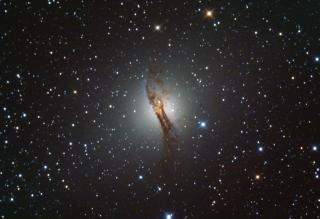Dark Night Sky March 1st 2014
Hi Everyone,
Well it has definitely been a while since my last venture under the stars but I finally had a good evening and headed back up to my usual haunt. Seeing was not the best but far better than any conditions we have seen here in South East Queensland for a while so I took my chances and went out (any time under the skies even in average conditions is better than nothing).
So with seeing at around a 7/10 and quite a bit of haze in the atmosphere I decided to shoot the Hamburger Galaxy (NGC5128) as it was rising in the South East from about 10PM and had reasonable elevation from my location to not be limited by the atmosphere too much. Once high enough I managed to get 27 exposures of 300 seconds (5 minutes) at ISO 800 before the cloud rolled in at about 2 AM and ruined the remainder evening for me.
On a good note I have been wanting to test the mount out since December and the issues I had so this was a great opportunity for that. I made the adjustments to the EQ8’s RA Axis as directed by Rob at Tasco and the great news is this seems to have fixed any issues I had with the mount. It consistently tracked NGC5128 at 1 second refresh cycles with a deviation of only 0.25 – 0.5 of a pixel the whole time. This was the best performance I have had to date and considering I am guiding through a 70mm William Optics scope (540mm FL) piggybacked on the RC8 it resulted in good round stars in the final image (at 1600mm FL). I really need to look at a decent off axis guider for the RC8 to get even more accurate guiding.
The main issue I have with the image is that the focus was a little off and resulted in a “soft” image over all, again I think it is time to look at a Moonlite focuser with a stepper motor to assist in obtaining a crisp focus.
Anyway here are the image details:
- Lights: 27 * 300s @ ISO800
- Darks: 20 * 300s @ ISO800
- Flats: 20 * 1/4000s @ ISO800
- BIAS: 20 * 1/4000s @ ISO800
The equipment used was:
- EQ8 Mount
- GSO RC8 Scope
- Baader UV/IR Filter
- Central DS 600D Camera (With Backyard EOS)
- Guiding with a William Optics ZenithStar 70mm APO and
- LodeStar Guider Camera.
Subs stacked in Deep Sky Stacker with respective Darks, Flats and BIAS frames, the resultant image was processes in PixInsight using the following steps:
- Dynamic Crop
- Dynamic Background Extraction
- Colour Correction
- ATrous Wavelet transformation Noise Reduction
- Histogram Stretch
- Saturation Stretch
The final image output was detailed in Photoshop using layer masks and smart sharpening to enhance the dark lanes in the galaxy and saved out as JPEG and TIFF formats.
All in all I am quite pleased with the image. As mentioned seeing and focus were a bit off and resulted in a “soft” image but other than that I think it has nice colour, good detail and a smooth finish.
As an aside if you would like any details on the processing steps taken please feel free to contact me and I can walk you through it.
I hope you enjoy.
Cheers
Anthony
